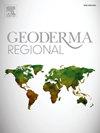Soil structure and pH shape prokaryotic communities in lowland soils across Denmark
IF 3.3
2区 农林科学
Q2 SOIL SCIENCE
引用次数: 0
Abstract
Agricultural activity in drained lowlands accelerates peat decomposition and greenhouse gas emissions. Rewetting is increasingly adopted across Europe to mitigate these emissions, but its effects on soil microbial communities remain poorly understood. We examined prokaryotic communities and network structure in Danish lowland soils designated for potential rewetting to improve our understanding of these communities and their drivers. We included less-studied soil properties linked to hydrology and structure (soil water content at field capacity, van Genuchten pore-size distribution index (n), and soil water repellency (SWR)) in addition to common properties such as pH and organic carbon (OC). We analysed 113 soil samples across land-use types (grass, fallow, crop, other) spanning mineral to organic soils with gradients in pH (2.0–7.6), OC (0.025–0.499 kg kg-1), SWR (33.9-71.3 mN m-1), and soil structure (n: 1.1-1.3). Prokaryotic alpha diversity (Shannon-Wiener index: 2.9–5.7) was best predicted by pH, followed by porosity and n. Together, pH, porosity, n, and OC accounted for 24.5% of the variance in community composition. Hierarchical clustering identified three prokaryotic clusters strongly aligned with pH. Network analysis revealed marginal differences when comparing samples from fallow and grass, while complexity increased progressively across clusters. Interestingly, high-pH soils showed the highest alpha diversity but the least complex networks, while low-pH soils showed the opposite. In conclusion, soil pH emerged as the dominant driver of prokaryotic communities in Danish lowlands, but hydrological and structural properties also played important roles. Network complexity provided complementary insights into ecosystem organisation beyond diversity alone.
丹麦低地土壤的土壤结构和pH形状原核生物群落
排水低地的农业活动加速了泥炭的分解和温室气体的排放。欧洲各地越来越多地采用复湿法来减少这些排放,但其对土壤微生物群落的影响仍然知之甚少。我们研究了丹麦低地土壤中指定的潜在再润湿的原核群落和网络结构,以提高我们对这些群落及其驱动因素的理解。除了pH和有机碳(OC)等常见特性外,我们还纳入了与水文和结构相关的较少研究的土壤特性(田间容量下的土壤含水量、van Genuchten孔径分布指数(n)和土壤疏水性(SWR))。我们分析了113个不同土地利用类型(草地、休耕、作物等)的土壤样品,包括矿质到有机土壤的pH(2.0-7.6)、OC (0.025-0.499 kg kg-1)、SWR (33.9-71.3 mN m-1)和土壤结构(n: 1.1-1.3)的梯度。pH对原核α多样性(Shannon-Wiener指数:2.9 ~ 5.7)的预测效果最好,其次是孔隙度和n。pH、孔隙度、n和OC共占群落组成方差的24.5%。分层聚类鉴定出3个与ph值高度一致的原核生物聚类。网络分析显示,休耕和草地样品之间存在边际差异,而聚类之间的复杂性逐渐增加。高ph土壤的α多样性最高,但其复杂网络最少,而低ph土壤则相反。结果表明,土壤pH值是丹麦低地原核生物群落的主要驱动因素,但水文和结构特性也起着重要作用。网络复杂性提供了对生态系统组织的补充见解,而不仅仅是多样性。
本文章由计算机程序翻译,如有差异,请以英文原文为准。
求助全文
约1分钟内获得全文
求助全文
来源期刊

Geoderma Regional
Agricultural and Biological Sciences-Soil Science
CiteScore
6.10
自引率
7.30%
发文量
122
审稿时长
76 days
期刊介绍:
Global issues require studies and solutions on national and regional levels. Geoderma Regional focuses on studies that increase understanding and advance our scientific knowledge of soils in all regions of the world. The journal embraces every aspect of soil science and welcomes reviews of regional progress.
 求助内容:
求助内容: 应助结果提醒方式:
应助结果提醒方式:


